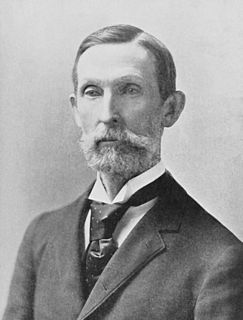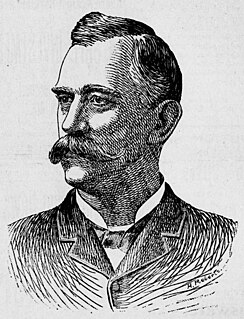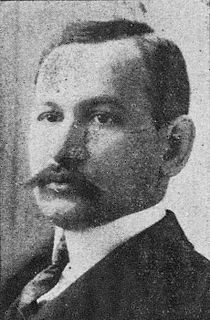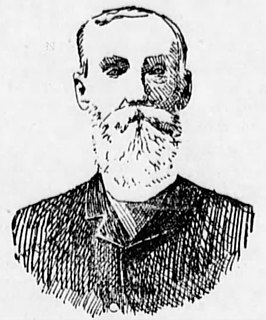
Lorrin Andrews Thurston was an American lawyer, politician, and businessman born and raised in the Kingdom of Hawaiʻi. The grandson of two of the first Christian missionaries to Hawaii, Thurston played a prominent role in the overthrow of the Hawaiian Kingdom that replaced Queen Liliʻuokalani with the Republic of Hawaii, dominated by American interests. He published the Pacific Commercial Advertiser, and owned other enterprises. From 1906 to 1916 he and friends lobbied with national politicians to create a National Park to preserve the Hawaiian Volcanoes.

Kuini Liliha was a High Chiefess (aliʻi) and noblewoman who served the Kingdom of Hawaii as royal governor of Oʻahu island. She administered the island from 1829 to 1831 following the death of her husband Boki.

John Young was a British subject who became an important military advisor to Kamehameha I during the formation of the Kingdom of Hawaii. He was left behind by Simon Metcalfe, captain of the American ship Eleanora, and along with a Welshman Isaac Davis became a friend and advisor to Kamehameha. He brought knowledge of the western world, including naval and land battle strategies, to Kamehameha, and became a strong voice on affairs of state for the Hawaiian Kingdom. He played a big role during Hawaii's first contacts with the European powers. He spent the rest of his life in Hawaiʻi. Between 1802–1812, John Young ruled as Royal Governor of Hawaii Island while King Kamehameha was away on other islands. He organized the construction of the fort at Honolulu Harbor. The Hawaiians gave him the name ʻOlohana based on Young's typical command "All hands ".

Captain Alexander Adams (1780–1871) was a Scotsman who served in the British Royal Navy and then came to the Hawaiian islands and served in the navy of the Kingdom of Hawaii. Known to the Hawaiians as Alika Napunako Adams.
Isaac Davis was a British advisor to Kamehameha I who was one of European settlers that helped form the Kingdom of Hawaii. He arrived in Hawaii in 1790 as the sole survivor of the massacre of the crew of the Fair American. He along with John Young became friends and advisors to Kamehameha. He brought western military knowledge to Hawaii and played a prominent role during Hawaii's first contacts with the European powers. He spent the rest of his life in Hawaiʻi and was known to the Hawaiian as ʻAikake.

Ulumāheihei Hoapili was a member of the nobility during the formation of the Kingdom of Hawaii. He was a trusted military and political advisor to King Kamehameha I, known as "Kamehameha the Great". Although trusted with one of the last symbolic rites of the Hawaiian religion, he later became a supporter of Christian missionaries.

The Oʻahu Cemetery is the resting place of many notable early residents of the Honolulu area. They range from missionaries and politicians to sports pioneers and philosophers. Over time it was expanded to become an area known as the Nuʻuanu Cemetery.

William DeWitt Alexander was an educator, author and linguist in the Kingdom of Hawaii and Republic of Hawaii. He then constructed maps for the Territory of Hawaii.

Peter Johnson Gulick was a missionary to the Kingdom of Hawaii and Japan. His descendants carried on the tradition of missionary work, and included several scientists.

Charles Thomas Gulick was a Kingdom of Hawaiʻi politician and one of the few members of the various missionary families of the time to side with the monarchy in the 1893 overthrow of the Kingdom of Hawaiʻi.

John Adams Kuakini Cummins was a member of the nobility of the Kingdom of Hawaii who became a wealthy businessman, and was involved in politics as the kingdom was overthrown.

Samuel Gardner Wilder was an American shipping magnate and politician who developed a major transportation company in the Kingdom of Hawaii.

Samuel Chenery Damon was a missionary to Hawaii, pastor of the Seamen's Bethel Church, chaplain of the Honolulu American Seamen's Friend Society and editor of the monthly newspaper The Friend.

James Aalapuna Harbottle Boyd was a military official under the Kingdom of Hawaii. He served King Kalākaua and Queen Liliʻuokalani and was the inspiration for the song Aloha ʻOe.

Elizabeth Sumner Chapman Achuck Lapana Keawepoʻoole was a Hawaiian high chiefess during the Hawaiian Kingdom and lady-in-waiting of Princess Likelike. An accomplished Hawaiian composer, she composed the popular Hawaiian love song Sanoe with Queen Liliʻuokalani, which was about a love affair in the Hawaiian royal court in the 1870s.

Carlos Appiani Long was an attorney and politician of the Territory of Hawaii. In his youth, he was a college football player at Georgetown University. His middle name is often spelled Appiani, Appianni or Apiani.

Robert Grimes Davis was an early lawyer and judge of the Kingdom of Hawaii who served many different posts for Hawaii and the Republic of Peru. He was also known as Lopaka, the Hawaiian version of Robert.

Colonel Charles Hastings Judd was an American businessman, rancher, courtier and politician who was born, lived, worked and died in the Kingdom of Hawaii. He served as Chamberlain and Colonel of the military staff of King Kalākaua and traveled with the monarch on his 1881 world tour.

George Charles Beckley was an English captain, trader, and military adviser. He was one of the earliest foreigners to have a major impact in the Kingdom of Hawaii, where he would eventually become a noble, and was one of the disputed creators of the Flag of Hawaii.

John Henry Paty was the Consul to the Netherlands for the Kingdom of Hawaii. He was a businessman who served as an auditor or as a trustee of numerous organizations, and was a founding member of both the Planters’ Labor & Supply Company and the Oahu Railway and Land Company.



















